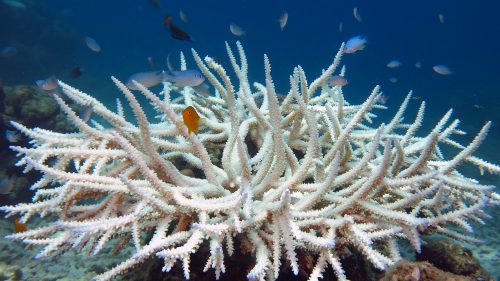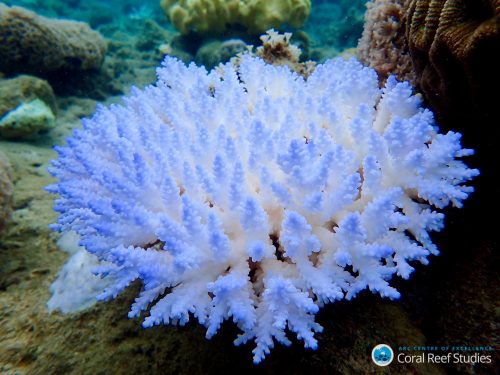By Jessica Glazner
In a recent blog post, we discussed what coral bleaching is and how, as divers, we might have a positive impact on coral reefs.
If you recall, when ocean temperatures rise above their normal limit corals “bleach,” meaning they expel their symbiotic algae, the zooxanthellae, revealing their white skeleton through the transparent polyps. The zooxanthellae provides the coral polyps with their beautiful colors and they are also their primary food source, without which the corals cannot survive for very long. As we learned, it is really the sustained warmer ocean temperatures that are a big threat to coral reefs. If temperatures drop back down to normal fairly quickly, the corals are typically able to recover their zooxanthellae.
But how do these single-celled algae know it is safe for them to return to their protective homes inside the coral polyps? Incredibly, the corals have a way of signaling to their algae that it is time to return. And, as we will see below, this process also helps the corals protect themselves during bleaching events.
Fluorescing 
In recent years scientists and divers alike have been noticing an interesting phenomenon happening on coral reefs worldwide. Instead of the corals remaining their “normal” white when bleached, some corals are instead turning bright neon colors like highlighter markers. This phenomenon is called fluorescing, or colorful bleaching, and is the result of the production of special pigments inside of the coral polyp.
These incredible colors are benefiting the corals in two ways:
- They are acting like a sunscreen layer, protecting the delicate coral tissue from the sun and warm water. The colorful pigments have photo-protective properties, meaning that they filter out the harmful ultraviolet rays in sunlight.
- The bright colors act as a beacon for the zooxanthellae, helping the algae return and recolonize the coral polyps.

Photo by Jessica Glazner
Fluorescing typically begins 2-3 weeks after mild or temporary heat stress, when temperatures start dropping back to their normal range. It is important to note that in severe bleaching events where the temperature is significantly above normal, or prolonged bleaching events where the water stays warm for a long period of time, fluorescing does not happen.
When the algae leave the coral, more light is reflected inside of the coral animal, off of the white limestone skeleton. This excessive light travels back and forth inside of the coral tissue and increases the amount of internal light in the coral tissue. Even after ocean temperatures return to normal, the brightly lit up bleached coral is stressful to the algae and can delay or even prevent their return. So, the corals use this increased internal light to boost production of their protective colorful pigments, which are thought to also act as a signaling device, telling the zooxanthellae that it is safe for them to return to the coral.
But how does the algae “see” the fluorescing corals?

Fluorescing Coral on the Great Barrier Reef
Researchers in Okinawa, Japan have been studying how new coral polyps, and also bleached coral polyps, attract the free-swimming zooxanthellae to them. The algae are attracted to green fluorescing pigments that the coral emits, and in studies they found more algae where this pigment was present than where it was not. The green fluorescing pigments are a key player in the symbiosis between the coral polyp and zooxanthellae, and serve as a biological signaling device that brings the two organisms together, ensuring the success of coral reef ecosystems.

Fluorescing Coral in Hawaii. Photo by P. Fiene
Of the coral fluorescing events that have been documented, corals that fluoresce have a significantly lower mortality rate than corals that bleach white. Colorful bleaching tends to happen when heat stress isn’t so severe, and this built-in sunscreen and signaling device seems to be extremely effective at protecting corals against mildly warming oceans. If corals are to have a chance at survival we must reduce the rate at which our oceans are warming by decreasing our fossil fuel emissions, as well as mitigating local stressors to coral reefs such as sedimentation, pollution, and overfishing.
Aihara et al., Green fluorescence from cnidarian hosts attracts symbiotic algae, Proceedings of the National Academy of Sciences of the United States of America (2019) https://doi.org/10.1073/pnas.1812257116
Bollati et al., Optical Feedback Loop Involving Dinoflagellate Symbiont and Scleractinian Host Drives Colorful Coral Bleaching, Current Biology (2020), https://doi.org/10.1016/j.cub.2020.04.055
